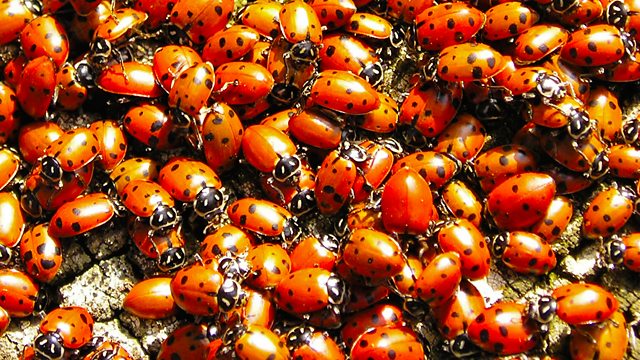Pheromones
Melvyn Bragg and guests discuss how animals influence the behaviour of others of their species by secreting or excreting chemical substances.
Melvyn Bragg and guests discuss how members of the same species send each other invisible chemical signals to influence the way they behave. Pheromones are used by species across the animal kingdom in a variety of ways, such as laying trails to be followed, to raise the alarm, to scatter from predators, to signal dominance and to enhance attractiveness and, in honey bees, even direct development into queen or worker.
The image above is of male and female ladybirds that have clustered together in response to pheromones.
With
Tristram Wyatt
Senior Research Fellow at the Department of Zoology at the University of Oxford
Jane Hurst
William Prescott Professor of Animal Science at the University of Liverpool
and
Francis Ratnieks
Professor of Apiculture and Head of the Laboratory of Apiculture and Social Insects at the University of Sussex
Producer: Simon Tillotson
Last on
More episodes
Previous
Next
LINKS AND FURTHER READING
Ìý
READING LIST:Ìý
Jack W. Bradbury and Sandra L. Vehrencamp, Principles of Animal Communication (2nd edition, Sinauer, 2011)
Thomas Eisner, For Love of Insects (Harvard University Press, 2005)
Tristram D. Wyatt, Pheromones and Animal Behavior: Chemical Signals and Signatures (2nd edition, Cambridge University Press, 2014)
Tristram D. Wyatt, Animal Behaviour: A Very Short Introduction (Oxford University Press, 2017)
Ìý
Broadcasts
- Thu 21 Feb 2019 09:00±«Óãtv Radio 4
- Thu 21 Feb 2019 21:30±«Óãtv Radio 4
Featured in...
![]()
Science—In Our Time
Scientific principles, theory, and the role of key figures in the advancement of science.
In Our Time podcasts
Download programmes from the huge In Our Time archive.
The In Our Time Listeners' Top 10
If you’re new to In Our Time, this is a good place to start.
Arts and Ideas podcast
Download the best of Radio 3's Free Thinking programme.
Podcast
-
![]()
In Our Time
Melvyn Bragg and guests discuss the ideas, people and events that have shaped our world.



